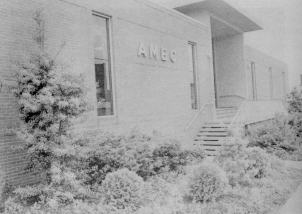 In
1787 in the city of Philadelphia, Benjamin Franklin, John Hancock, Alexander Hamilton, and others gathered to frame the Constitution of these United States. At the same time and in the same city, Richard Allen, Daniel Coker, and others were meeting to organize what has become the African Methodist Episcopal Church. It was not established because of any theological differences with the Methodist Church, of which the founders were a part. Rather, it was established as a protest against segregation and discrimination which these founders had experienced in St. George's Methodist Church. With the increase in numbers of these black churches in the Philadelphia and Baltimore areas, the first General Conference was held in 1816 and the African Methodist Episcopal Church became the first black denomination in the United States.
In
1787 in the city of Philadelphia, Benjamin Franklin, John Hancock, Alexander Hamilton, and others gathered to frame the Constitution of these United States. At the same time and in the same city, Richard Allen, Daniel Coker, and others were meeting to organize what has become the African Methodist Episcopal Church. It was not established because of any theological differences with the Methodist Church, of which the founders were a part. Rather, it was established as a protest against segregation and discrimination which these founders had experienced in St. George's Methodist Church. With the increase in numbers of these black churches in the Philadelphia and Baltimore areas, the first General Conference was held in 1816 and the African Methodist Episcopal Church became the first black denomination in the United States.
Two years later in 1818 Richard Allen, the founder and first consecrated bishop, realized that it was necessary to initiate a method of disseminating information if there were to be growth of this embryonic church. The first department, therefore, to be established was Publications, with its Book Concern becoming the "oldest publishing house of any importance owned by Negroes." It was designed to print the discipline, hymnals, church supplies, study courses for young ministers, and church materials such as books, newspapers, and magazines.
In 1847 the AME Church, which had become interested in the development of Sunday schools, considered several proposals for a Sunday School Union to organize and develop Sunday schools. It was not until 1882 that the Reverend Charles S. Smith of Bloomington, Indiana, projected a plan that brought into existence the Sunday School Union, at which the first Sunday school literature by African Americans was published. The department, first located at Bloomington, moved to Nashville in 1886, where the Reverend Smith, the first secretary-treasurer, purchased a five-story brick and stone building at 206 Public Square. Upon the election of Smith to the bishopric in 1900, the Reverend William D. Bhappelle became the second secretary-treasurer, serving until 1908.
Ira T. Bryant, the first layman to hold the position of secretary-treasurer, was elected in 1908 and served until 1936. During his twenty-eight year tenure a larger building at 404 Eighth Avenue, South, was purchased; a modern printing plant installed; and additional property acquired. When he was defeated for office by E. A. Selby in 1936, Bryant contested the election and was able to retain the connection's property for five years, until the case was decided by a federal court. It was not until eight years later that the Church was awarded several pieces of contested property and given a monetary settlement. During Selby's twenty-eight-year tenure, the Department of Publications and the Book Concern, which was in reality a book agency, merged with the Sunday School Union.
Elected in 1964, the Reverend Charles S. Spivey, Sr., served until he retired in 1972. Reverend Henry A. Belin, Jr., who became the secretary-treasurer in 1972, was responsible for the building of a much-needed publishing house at 500 Eighth Avenue, South, which was dedicated In November of 1977.
When Belin became a bishop in 1984, the Reverend A. Lee Henderson was elected. Henderson, who had a successful publishing background, added brilliant color and creative graphics to give the Sunday school literature and other publications a new look. The AME Sunday School Union continues its mission of publishing for the purpose of disseminating information to churches and the general public.